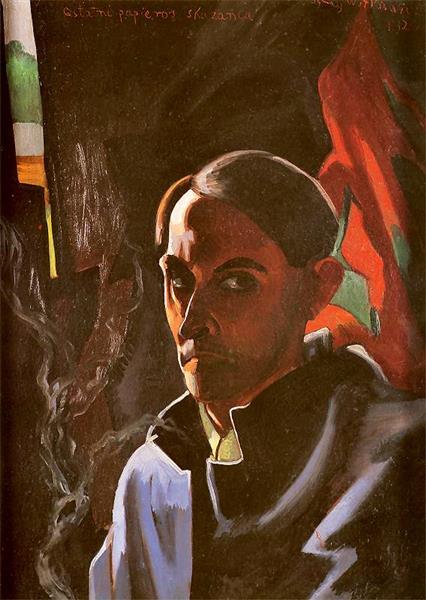Description
In the study of Polish painting of the twentieth century, few artists have had an impact as significant as Stanis? Aw Witkiewicz, popularly known as Witkacy. Its 1924 self -portrait stands as a masterpiece that not only reflects a unique moment in her life, but also encapsulates an introspective process that invites the viewer to enter the depths of her psyche. The painting presents a self -portrait of the artist, who, through his well -known expressionist style, confronts us with a disturbing and revealing image.
The composition of the work is bold and full of energy. Witkiewicz opts for a close -up of his face, which dominates the canvas in an abstract and vibrant background, which further highlights the intensity of his gaze. Its expression is enigmatic, a starting point that invites multiple interpretations. The frontality of the face generates a sense of confrontation, as if the artist himself were challenging the viewer to see beyond the surface. This technique of introducing a central figure in the painting, surrounded by a less defined background, goes back to the traditions of the portrait, although Witkacy transforms it by adopting a more psychological and philosophical look.
The use of color in this work is particularly remarkable. Witkiewicz uses a vibrant palette that oscillates between warm and cold tones, creating a strong contrast that emphasizes the emotional tension present in its expression. Color schemes are not simply there to reproduce reality, but serve as emotion vehicles. The blue and reddish on their face not only represent their humanity, but also seem to reflect their internal struggles, a torment symbol that characterized much of their personal and creative life.
A fascinating aspect of this painting is its relationship with contemporary artistic movements. Witkiewicz was deeply influenced by expressionism and symbolism, currents that sought to represent not only the visible, but also the subject's internal emotional state. Unlike other more photographic self -portraits of his time, Witkacy goes into the territory of psychological art. His work is aligned with other contemporary artists, such as Egon Schiele and Emil Nolde, who also explored emotional complexity and existential anguish through provocative portraits.
Often, Witkiewicz's work is examined in the light of his theatrical and literary career, because he was also a remarkable playwright and an art theorist. His idea of "nerves" or "tension" in art manifests itself in its self -portrait, where the viewer can feel the emotional conflagration that emanates from his gaze. This self -portrait is not only a representation of the artist, but a mirror of his own conflict with identity, a visual narrative that explores the very essence of human being in a turbulent era.
In the history of art, Self -portrait (1924) of Witkiewicz stands not only as a personal document, but as a work that transcends the biographical and becomes a milestone of Polish expressionism. It offers us a vision of an artist who dared to challenge the conventions of his time, using painting as a means to explore the abysses of human experience. The work invites reflection on the identity, perception and role of the artist in a constant change, and is a testimony of the rich cultural heritage left by Witkacy.
KUADROS ©, a famous paint on your wall.
Hand-made oil painting reproductions, with the quality of professional artists and the distinctive seal of KUADROS ©.
Art reproduction service with satisfaction guarantee. If you are not completely satisfied with the replica of your painting, we refund your money 100%.

